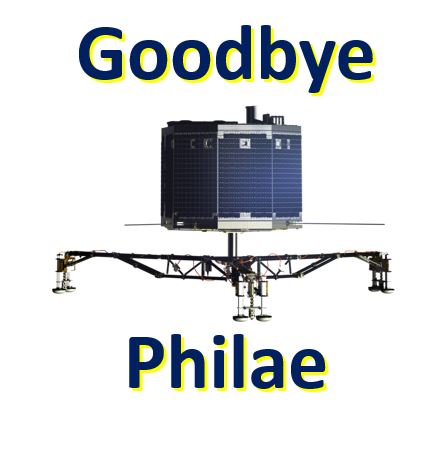The comet lander Philae has been left for dead by the European Space Agency, after repeatedly trying to make contact, but sadly with no success. The robotic lander that accompanied the Rosetta spacecraft until it landed on comet 67P/Churyumov–Gerasimenko, has been silent since its last call to Rosetta 7 months ago.
The European Space Agency’s (ESA’s) space probe Rosetta, which continues its scientific investigations at the comet until September of this year before its own comet-landing finale, has been balancing science observations in recent months with flying the dedicated trajectories optimized to listen out for Philae.
However, Philae has been totally silent since 9th July, 2015.
 Reconstruction of Philae’s trajectory across Comet 67P/Churyumov–Gerasimenko. It is amazing that after all that bouncing about, the Philae lander managed to complete 80% of its scientific projects. (Image: esa.int)
Reconstruction of Philae’s trajectory across Comet 67P/Churyumov–Gerasimenko. It is amazing that after all that bouncing about, the Philae lander managed to complete 80% of its scientific projects. (Image: esa.int)
Chances of making contact close to zero
Stephan Ulamec, Philae project manager at the German Aerospace Center, DLR (Deutsches Zentrum für Luft- und Raumfahrt), said:
“The chances for Philae to contact our team at our lander control centre are unfortunately getting close to zero. We are not sending commands any more and it would be very surprising if we were to receive a signal again.”
Philae’s ground team, which includes experts at the French, German and Italian space centres, as well as scientists across the continent, have carried out extensive investigations to try to determine the lander’s status, gathering and analyzing data since it completed its first set of scientific activities after its historic landing in November 2014.
In November 2014, a story with incredible twists and turns started to unfold. First a faulty thruster was detected, then the Philae failed to fire its harpoons and anchor itself to the comet’s surface after its 7-hour descent.
Philae bounced to a new touchdown location
When it hit the surface it bounced from its initial touchdown point at Agilkia, to Abydos – a new landing site more than 1 kilometre away. The lander’s precise location still needs to be confirmed in high-resolution images.
A reconstruction of Philae’s flight suggested that it made contact with the comet’s surface four times during the two-hour additional flight across the small comet lobe.
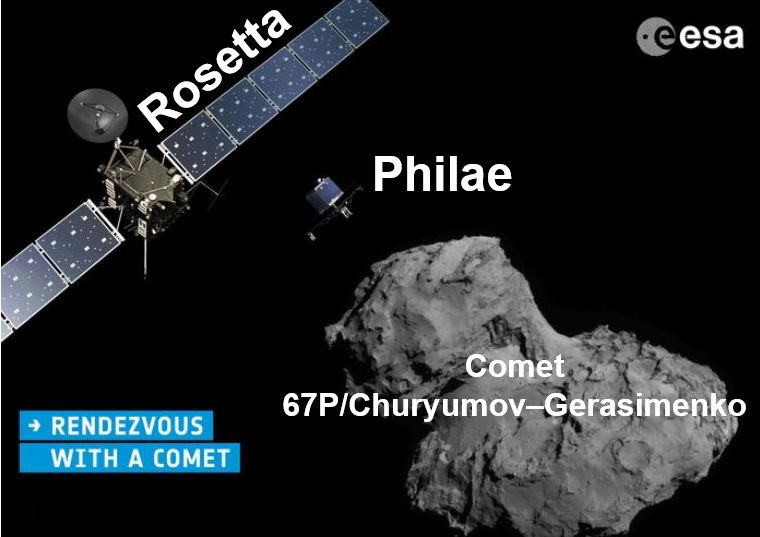 This ESA mission poster shows the Rosetta spacecraft, the deployment of the Philae lander, and comet 67P/Churyumov–Gerasimenko. (Image: esa.int)
This ESA mission poster shows the Rosetta spacecraft, the deployment of the Philae lander, and comet 67P/Churyumov–Gerasimenko. (Image: esa.int)
After bouncing from its initial touchdown point, it grazed the rim of the Hatmehit depression. It then bounced again and finally settled on the surface of the comet at Abydos.
Despite those bouncing episodes, Philae was still able to make an impressive array of science measurements – some of them were done while it was flying above the surface following its first bounce.
As soon as it finally settled down at Abydos, science and operations teams worked incessantly to adapt the experiments to make the most of its new location and circumstance.
Science missions completed despite collisions
The European Space Agency says approximately 80% of the lander’s planned scientific activities were completed.
For a period of 64 hours after separating from Rosetta, Philae took detailed photographs of the comet from above and on the surface, analyzed organic compounds, and profiled the local environment and surface properties of the comet, providing fascinating insights into this distant celestial object.
However, there was not enough sunlight at Abydos to charge its secondary batteries, so a race was on to gather and transmit data to Rosetta across the 510 kilometres of space back to Earth before Philae’s primary battery went completely flat.
On 14th-15th November 2014, Philae fell into hibernation.
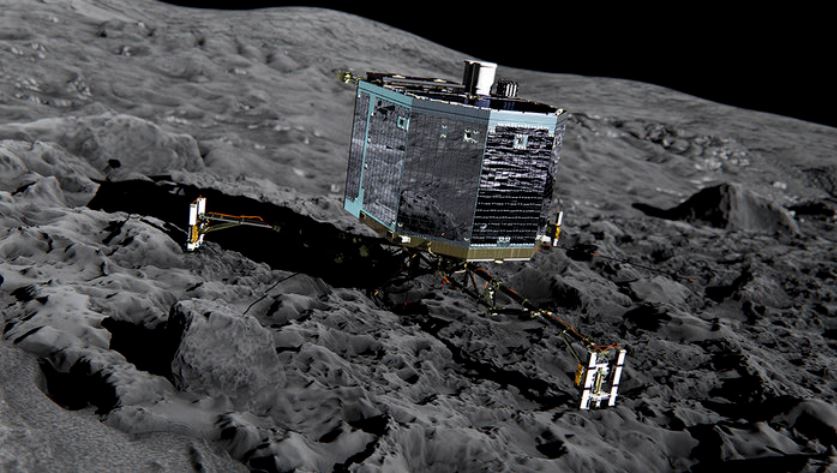 An artist’s impression of the Philae lander on the surface of comet 67P/Churyumov-Gerasimenko. (Image: esa.int)
An artist’s impression of the Philae lander on the surface of comet 67P/Churyumov-Gerasimenko. (Image: esa.int)
As the comet and lander moved nearer the sun ahead of perihelion (closest point to the Sun) on 13th August, 2015, everybody had their fingers crossed that Philae would come to life again.
Scientists had estimated that at Abydos the lander might get enough sunlight at this point to start warming up to the minimum (-45ºC) needed for it to operate on the surface even by the end of March 2015.
Had Philae landed as originally planned at Agilkia, it would probably have overheated by March, ending any further operations.
Philae suddenly started transmitting again
On 13th June 2013, Philae came to life and transmitted housekeeping telemetry to Rosetta, including data from its thermal power and computer systems.
After carefully analyzing the data, scientists said the lander had, in fact, already woken up on 26th April, 2015, but had been unable to communicate with Rosetta until 13th June.
ESA scientists said they were amazed that Philae had managed to survive all those bounces on 12th November, followed by unfavourable environmental conditions.
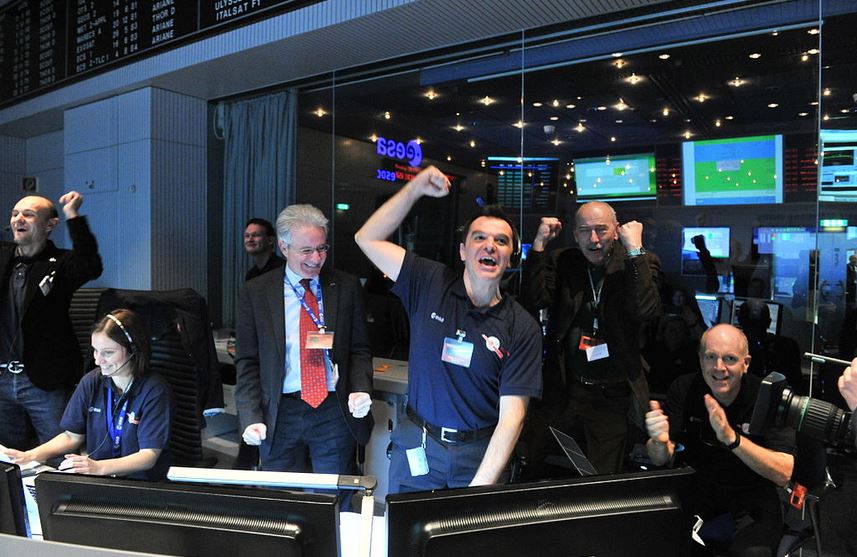 A moment of pure joy for members of the Rosetta team when they received the probe’s signal at ESOC in Darmstadt, Germany, on 20 January 2014. (Image: Wikipedia)
A moment of pure joy for members of the Rosetta team when they received the probe’s signal at ESOC in Darmstadt, Germany, on 20 January 2014. (Image: Wikipedia)
Philae made seven further intermittent transmission to Rosetta in the weeks following 13th June, up to 9th July. Unfortunately, the communication links it did establish were too unstable and short for any scientific measurements to get through.
And then there was silence
Even though thermal conditions improved – the temperature inside Philae rose to 0ºC – it made no further contacts with Rosetta as it approached perihelion in August.
After perihelion, with increased levels of outflowing gas and dust, conditions worsened for Rosetta to operate near enough to the comet.
In recent months, the comet’s activity quietened down enough to make it possible to approach the nucleus again safely. This week, Rosetta was just 45 kilometres from the surface and made repeated passes over Abydos.
Despite such close proximity, no signals have been received. Several attempts were made to send commands ‘in the blind’ to trigger a response from the lander – but nothing was detected.
The irregular contacts last year and total silence this year were probably due to failures in the lander’s receivers and transmitters.
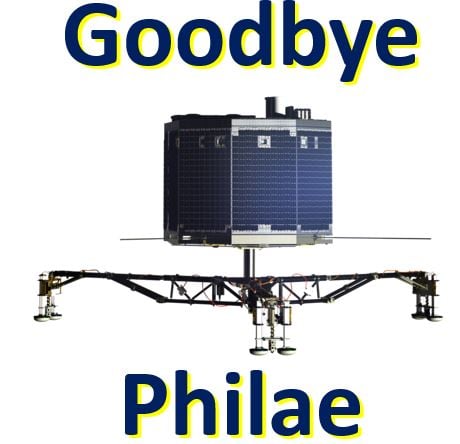 Goodbye Philae lander – a tough little machine. We’ll probably never hear from you again. (Image: Wikipedia)
Goodbye Philae lander – a tough little machine. We’ll probably never hear from you again. (Image: Wikipedia)
Several possible reasons for Philae’s silence
It is also possible that the lander has been unable to power up its battery because its solar panels are covered with dust. Some scientists have suggested that Philae’s antenna may have shifted and is pointing the wrong way.
Sylvain Lodiot, ESA’s Rosetta spacecraft operations manager, said:
“The comet’s level of activity is now decreasing, allowing Rosetta to safely and gradually reduce its distance to the comet again.”
“Eventually we will be able to fly in ‘bound orbits’ again, approaching to within 10–20 km – and even closer in the final stages of the mission – putting us in a position to fly above Abydos close enough to obtain dedicated high-resolution images to finally locate Philae and understand its attitude and orientation.”
Matt Taylor, ESA’s Rosetta project scientist, said:
“Determining Philae’s location would also allow us to better understand the context of the incredible in situ measurements already collected, enabling us to extract even more valuable science from the data.”
“Philae is the cherry on the cake of the Rosetta mission, and we are eager to see just where the cherry really is!”
At the same time, the lander, Rosetta and the comet are making their way back towards the outer Solar System. They have crossed Mars’ orbit and are currently about 350 million kilometres from the Sun.
Now too cold for lander to operate
Scientists add that as temperatures drop inside the lander, it has probably already become too cold for it to operate.
Even though hopes of making contact with Philae again evaporate, Rosetta will continue listening for signals from the lander as it flies alongside the comet ahead of its own comet landing later this year.
Patrick Martin, ESA’s Rosetta mission manager, said:
“We would be very surprised to hear from Philae again after so long, but we will keep Rosetta’s listening channel on until it is no longer possible due to power constraints as we move ever further from the Sun towards the end of the mission.”
“Philae has been a tremendous challenge and for the lander teams to have achieved the science results that they have in the unexpected and difficult circumstances is something we can all be proud of.”
“The combined achievements of Rosetta and Philae, rendezvousing with and landing on a comet, are historic high points in space exploration.”
Video – Reconstructing Philae’s Flight

